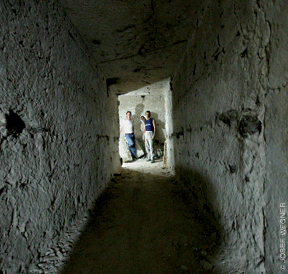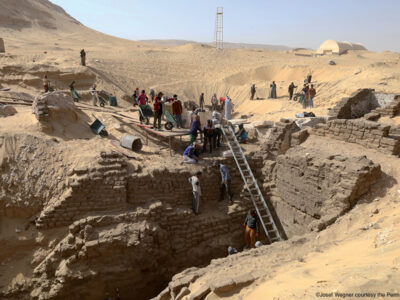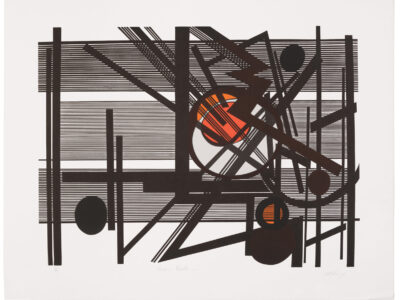
Sixteen-year-old Chloe Benner, a junior at McLean High School in Virginia, woke her parents before sun-up to start the 150-mile drive. Paul Stanwick, 53, came down from New York. Charlotte Rose and Ashley Scott, doctoral students in the Department of Near Eastern Languages and Civilization, merely walked across campus.
The lure? A behind-the-scenes look at the sometimes intuitive and always dogged detective work involved in excavating Abydos, a complex and important Egyptian city that thrived from 3000 to 1069 BCE. Dramatically situated between an expansive desert flood plain and steep cliffs, it served as the primary cult center of the god Osiris, the ruler of the netherworld. Over the years, excavations have unearthed Egypt’s best-preserved Bronze Age temple, the tombs of its earliest kings, the world’s oldest surviving plank boats, and the graves of courtiers and servants sacrificed during mortuary rituals of the pharaohs.
None of the 100 or so attendees, who willingly gave up one of those crisp, blue-sky Saturdays that serve as a last hurrah during the waning hours of summer, brought bullwhips or fedoras. But Benner, for one, did come armed with an array of pens with which to take color-coded notes according to theme. “I love everything about the Egyptians,” she said, smiling through her braces. “How ancient they are, how advanced their culture was, the whole package. I think what makes them distinctive from the Greeks and Romans is their more cheerful perspective on the afterlife. I’m really interested in the religion and its attitudes toward dying.” This was her first foray to Penn, she said, but not her last. “I’m planning on coming back for an afternoon workshop on the pyramids.”
“Ancient Abydos: From Egypt’s First Pharaohs to its Last Pyramid,” was held on September 19 at the Penn Museum, which co-sponsored the event with the American Research Center in Egypt’s Pennsylvania Chapter, Penn’s Center for Ancient Studies, and the Department of Near Eastern Languages and Civilizations.
David O’Connor, a professor and Penn Museum curator for many years, and now professor at New York University’s Institute of Fine Arts as well as co-director of the Penn-Yale-IFA Expedition to Abydos, began with a brisk summation of the site’s history and the research conducted there. The world’s preeminent expert on Abydos, O’Connor remarked that he was just as excited as the audience was. “There’s a lot going on at Abydos,” he said, “and this may be the first time—along with the release of the book [his new publication, Abydos: Egypt’s First Pharaohs and the Cult of Osiris]—that so much information on the site has been collected in one place.”
O’Connor has explored the site for more than four decades, and the day’s subsequent speakers each studied under him at Penn and/or worked with him in Egypt. They came to shed light on a city that was considered remote even in its heyday. Visiting it was, explained O’Connor, “an act of devoted pilgrimage by those seeking to be identified with Osiris and his promise of eternal life.” As a consequence, an extraordinary array of royal, elite, and lower-order temples, chapels, and tombs developed, as did an entire town planned to administer what was essentially one of the world’s first tourist attractions.
The layers of this largely hidden site have revealed themselves gradually since the 1860s, when the British undertook its first large-scale excavations. But, said O’Connor, “later discoveries match or even outstrip those of the early pioneers.” In one of the day’s recurring moments of levity, he then showed an image depicting 13 of this new breed of scholar, costumed and positioned to recreate Leonardo da Vinci’s The Last Supper.
“People often ask why I am not in the photo,” O’Connor chuckled, before answering: “Because God the Father was not present.”
In a feat of perfect timing, the tableau’s Jesus figure, Matthew Adams, research scholar at IFA and associate director of the expedition, next took the podium. Concentrating on the work of the last decade, he spoke about the expedition’s spectacular success in using magnetic surveys—akin to X-rays, they measure variations in the Earth’s magnetic fields—to locate more of the massive mud-brick walls that researchers had always suspected were present. The purpose of these rectangular enclosures, situated more than a mile from the royal tombs, remains a mystery, but the excavations have proved useful in composing a more complete narrative of the earliest mortuary rituals at Abydos.
Although heavily plundered in antiquity, one enclosure, for example, contained enough pottery shards to suggest that its graves were dedicated to a king, possibly Aha, under whose reign the enclosures were apparently built. Dating the structure, said Adams, became possible when several wine-jar seal fragments revealed the names of a household who lived during the First Dynasty, a period when Aha ruled and the characteristic religion, architecture, and government of Egyptian civilization took root.
Adams went on to tell the stories of other “Aha” moments, so to speak. Stains found on a bench indicated the presence of a chapel where libations had been poured. A decorative bowl with traces of green malachite and black galena—minerals used in cosmetics—implied that its user was of relatively high status, as did the discovery of 25 ivory-and-lapis bangles adorning the body of a child. The oddly configured hip joints of other bodies suggested decades of donkey-riding, which, as a step up from walking, also pointed to an elite position.
The bodies—found in six graves alongside the outside of the enclosure—confirmed another long-held suspicion: that early Egyptians engaged in the practice of sacrificial deaths, murdering (most likely by poison or strangulation) servants, courtiers, and craftspeople who would prove valuable to a king during his afterlife. To gain a better understanding of whether this was a valid theory, Adams said his team revisited the mortuary enclosure of Aha’s successor, Djer, which contains a far greater number of graves. “It became clear that all 269 graves were roofed at the same time,” Adams said, “which suggests that all 269 people died at the same time.”

Adams concluded by introducing another new idea: that during Abdyos’s long stint as a royal burial ground, only one monument stood at any given time. The uniform heights of the enclosures revealed during excavations suggest that each was ritually demolished before the erection (on another site) of the next. The much more massive enclosure of Khasekhemwy, the last of the Second Dynasty pharaohs, however, was never razed—perhaps because, Adams said, “ideas were beginning to change and monuments from this point on were meant to remain standing.” Recounting the team’s exhaustive efforts—which include replacing 300,000 bricks—to conserve this enclosure, he said, “We don’t want to rebuild it as it was, but to preserve it as it is, with all of its nearly 5,000 years of history.”
For grad students Ross and Scott, both of whom had been to Egypt but not on digs, the morning offered hints of things to come in their own careers. “I liked hearing about the reconstruction work,” said Scott. “The whole notion of trying to protect the structure while not erasing all of the historic intervention gives you a sense of the continuation of this really long timeline.”
Josef Wegner C’89, an associate curator at the Penn Museum and associate professor of Near Eastern languages and civilizations, presented recent developments at the mortuary complex of Senwosret III, a Middle Kingdom pharaoh, which he’s been excavating since 1994. He marveled at the “unpredictable and sandy landscape of Abydos, which conceals and consistently reveals all sorts of surprises,” before introducing one: a planned urban settlement near the complex which once contained a mayor’s house with offices and a courtyard, and at least 16 other buildings. “From these remnants, we’ve been able to construct a working local history of the site,” he said. “This was the focal point for the administration of the temple—where priests and craftsmen such as carpenters worked—as well as the political center of the town.”
From the audience, the final speaker, Stephen Harvey Gr’98, picked gentle bones with some of Wegner’s theories, before ascending the stage himself. Describing his fieldwork at the mortuary complex of Ahmose, a New Kingdom pharaoh credited with the expulsion of outside rulers and the reunification of Egypt, he discussed the exploration of its royal pyramid, the last one to survive from ancient Egypt, and laid a case for the presence of at least two other subsidiary pyramids.
Harvey concluded by emphasizing much of the work in Abydos is a reexamination of sites once unveiled and then left untouched for nearly a century. “There are always new pieces to fit together with what’s been previously excavated,” he said. “Today, we’ve all gone on a multi-layered journey, and I’m looking forward to many more years of finding new discoveries buried under the sand at Abydos.”
—JoAnn Greco




